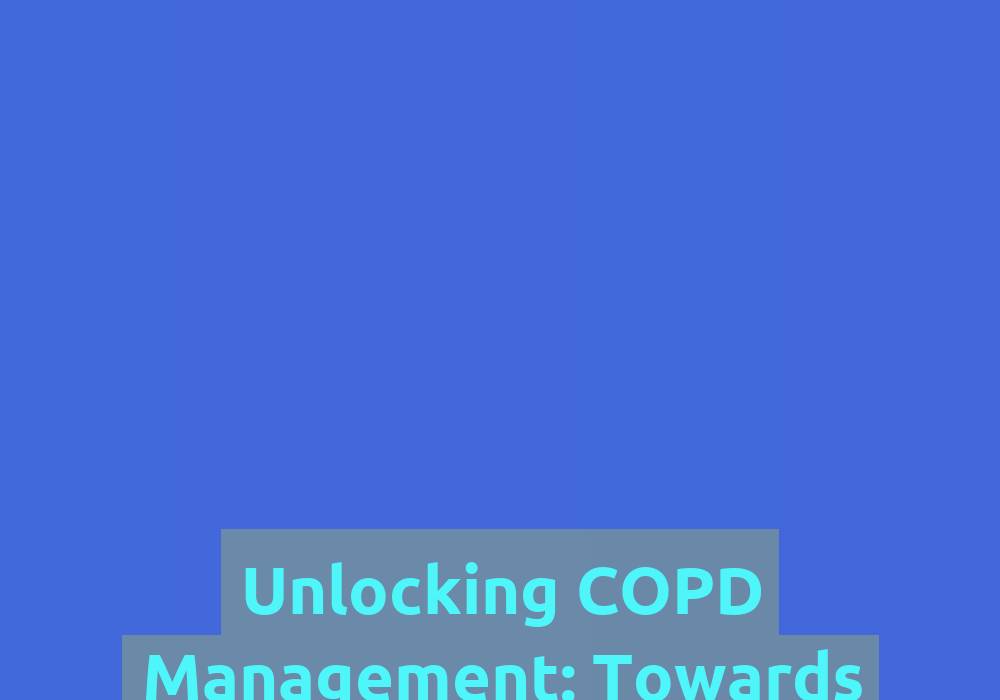Unlocking COPD Management: Towards Healthier Lungs

COPD, or Chronic Obstructive Pulmonary Disease, is a prevalent and progressive lung condition that affects millions of people worldwide. It is a leading cause of morbidity and mortality, placing a significant burden on healthcare systems and individuals alike. However, with proper management and lifestyle changes, individuals with COPD can lead fulfilling lives and maintain healthier lungs. In this article, we will explore various strategies and approaches to unlock COPD management, empowering individuals to take control of their respiratory health.
Understanding COPD
Before delving into management strategies, it is crucial to understand the nature of COPD. COPD is a chronic lung disease characterized by the obstruction of airflow in the lungs. The two primary conditions contributing to COPD are chronic bronchitis and emphysema.
Chronic bronchitis involves inflammation and narrowing of the bronchial tubes. This inflammation leads to excessive mucus production and a persistent cough. The narrowed airways make it difficult for air to pass through, causing shortness of breath and wheezing. On the other hand, emphysema refers to the damage of the air sacs in the lungs. This damage reduces the lungs’ ability to stretch and recoil, resulting in reduced airflow and less oxygen entering the bloodstream.
The most common cause of COPD is smoking, with long-term exposure to irritants such as cigarette smoke leading to the development and progression of the disease. Other factors like genetic predisposition, exposure to air pollution, and workplace chemicals can also contribute to COPD. It is important for individuals to be aware of these risk factors and take appropriate measures to minimize exposure.
Diagnosis and Treatment
Proper diagnosis is essential for effective COPD management. If you experience symptoms such as persistent coughing, shortness of breath, wheezing, and frequent respiratory infections, it is crucial to seek medical attention. Healthcare professionals can conduct various tests, including lung function tests, chest X-rays, and blood tests, to diagnose COPD accurately.
Once diagnosed, the primary goals of COPD treatment are to alleviate symptoms, slow disease progression, improve exercise tolerance, and enhance overall quality of life. Treatment plans are typically tailored to the individual, considering the severity of symptoms and the stage of the disease.
Common treatment options for COPD include:
-
Medications: Bronchodilators and inhaled corticosteroids help open up the airways and reduce inflammation, improving breathing. They are usually administered through inhalers, which deliver the medication directly into the lungs. Oral medications and antibiotics may also be prescribed to manage symptoms and prevent exacerbations.
-
Oxygen Therapy: In severe cases, supplemental oxygen may be prescribed to ensure adequate oxygen levels in the blood. This can relieve shortness of breath and improve overall lung function. Oxygen therapy can be administered through nasal prongs, a mask, or a portable oxygen concentrator.
-
Pulmonary Rehabilitation: This comprehensive program combines exercise, education, and support to optimize physical condition, increase lung capacity, and enhance overall well-being. It typically involves supervised exercise sessions, breathing exercises, nutritional counseling, and psychological support. Pulmonary rehabilitation is beneficial for individuals at all stages of COPD.
-
Lifestyle Modifications: Adopting a healthy lifestyle is crucial for COPD management. This includes smoking cessation, avoiding exposure to irritants and pollutants, maintaining a balanced diet, staying physically active, and managing comorbid conditions such as heart disease and diabetes. Quitting smoking is the most important step individuals can take to slow the progression of COPD and improve lung function.
Managing COPD is a long-term commitment, and individuals should work closely with their healthcare team to monitor symptoms, adjust treatment plans if necessary, and address any concerns or questions that arise.
Managing COPD Exacerbations
COPD exacerbations, also known as flare-ups, refer to sudden worsening of symptoms and lung function. These episodes can be triggered by respiratory infections, air pollution, or other factors. Managing exacerbations promptly is essential to prevent further lung damage and improve long-term outcomes.
To effectively manage COPD exacerbations, individuals should:
-
Seek Medical Attention: Contacting a healthcare professional is crucial when experiencing an exacerbation. They can provide appropriate treatment, adjust medications if necessary, and monitor lung function. It is important not to ignore worsening symptoms or delay seeking medical help.
-
Follow Action Plan: Working with healthcare providers to develop a personalized COPD action plan is vital. This plan outlines specific steps to take during exacerbations, such as adjusting medication doses, increasing inhaler use, or initiating oral corticosteroids. Following the action plan can help individuals effectively manage exacerbations and minimize their impact on daily life.
-
Stay Hydrated: Drinking plenty of fluids helps thin mucus and facilitate better airflow. Optimal hydration can alleviate symptoms and aid in recovery during exacerbations. It is important to drink water or non-caffeinated beverages to stay hydrated.
-
Maintain Rest and Pace Activities: During exacerbations, it is essential to conserve energy and avoid overexertion. Balancing rest and activity can help reduce breathlessness and allow the body to recover. It is advisable to prioritize rest and avoid activities that may strain the lungs.
Psychological Support and Coping Strategies
Living with COPD can be emotionally challenging, and individuals may experience anxiety, depression, or feelings of isolation. Psychological support is crucial to manage these aspects of the disease and maintain overall well-being.
Coping strategies for individuals with COPD include:
-
Support Groups: Joining support groups or attending pulmonary rehabilitation programs offers opportunities to connect with others facing similar challenges, share experiences, and gain valuable insights. Support groups can provide a sense of community and understanding, reducing feelings of isolation.
-
Educate Yourself: Understanding COPD, its management, and available resources can empower individuals to take an active role in their care. Knowledge is power, and staying informed can alleviate anxiety and improve coping abilities. It is important to seek reliable sources of information, such as reputable websites or educational materials provided by healthcare professionals.
-
Practice Relaxation Techniques: Breathing exercises, meditation, and relaxation techniques can help reduce stress, ease anxiety, and improve overall mental well-being. These techniques can be learned through pulmonary rehabilitation programs or by working with a mental health professional.
-
Seek Professional Help: If you find it challenging to cope with the emotional impact of COPD, consider seeking professional help. Mental health professionals can provide guidance, therapy, and support tailored to your specific needs. They can help you develop coping strategies, manage anxiety and depression, and improve your overall well-being.
The Role of Exercise and Physical Activity
Regular physical activity and exercise play a crucial role in COPD management. While it may seem counterintuitive for individuals with a respiratory condition, exercise can actually improve lung function and overall well-being.
Benefits of exercise for individuals with COPD include:
-
Improved Lung Function: Regular exercise helps strengthen respiratory muscles, improving lung capacity and efficiency. It also enhances the body’s ability to utilize oxygen and removes carbon dioxide more effectively.
-
Enhanced Exercise Tolerance: Engaging in physical activity gradually improves endurance, allowing individuals to perform daily tasks with less breathlessness. Exercise also helps individuals build stamina and maintain independence.
-
Reduced Risk of Exacerbations: Regular exercise and physical activity can help strengthen the immune system, reducing the risk of respiratory infections and subsequent exacerbations. It is important to note that individuals should avoid exercising during exacerbations and consult with their healthcare team before starting an exercise program.
-
Better Mental Health: Exercise releases endorphins, promoting a sense of well-being and reducing anxiety and depression commonly associated with COPD. Additionally, engaging in physical activity can distract individuals from their symptoms and provide a sense of accomplishment.
Before starting an exercise program, it is essential to consult with a healthcare professional or pulmonary rehabilitation specialist. They can provide guidance on suitable exercises, breathing techniques, and safety precautions. It is important to start slowly and gradually increase the intensity and duration of exercise over time. Individuals should listen to their bodies and modify activities as needed to avoid overexertion.
Conclusion
Managing COPD requires a multifaceted approach that encompasses medical treatment, lifestyle modifications, psychological support, and regular exercise. By adopting these strategies, individuals with COPD can unlock a healthier life, improving symptoms, slowing disease progression, and enhancing overall well-being. Remember, early diagnosis, proper treatment, and a proactive approach are key components in the journey towards managing COPD and enjoying a fulfilling life with healthier lungs.
Note: This document is written in markdown format.
FAQ
1. What is COPD and how does it affect the lungs?
COPD, or Chronic Obstructive Pulmonary Disease, is a chronic lung disease characterized by the obstruction of airflow in the lungs. It is a combination of chronic bronchitis and emphysema. Chronic bronchitis involves inflammation and narrowing of the bronchial tubes, while emphysema refers to damage to the air sacs in the lungs. These conditions make it difficult for air to pass through, leading to symptoms such as shortness of breath, coughing, and wheezing.
2. What are the common treatment options for COPD?
Common treatment options for COPD include medications (such as bronchodilators and inhaled corticosteroids), oxygen therapy, pulmonary rehabilitation, and lifestyle modifications. Medications help open up the airways and reduce inflammation, while oxygen therapy ensures adequate oxygen levels in the blood. Pulmonary rehabilitation combines exercise, education, and support to optimize physical condition. Lifestyle modifications include quitting smoking, avoiding irritants and pollutants, maintaining a balanced diet, staying physically active, and managing comorbid conditions.
3. How can COPD exacerbations be managed?
To effectively manage COPD exacerbations, individuals should seek medical attention, follow their personalized COPD action plan, stay hydrated, and maintain rest while pacing activities. Seeking medical attention allows for appropriate treatment and monitoring of lung function. Following the action plan helps manage exacerbations and minimize their impact. Staying hydrated helps thin mucus and facilitate better airflow, while rest and pacing activities reduce breathlessness and aid in recovery.
4. How can individuals cope with the emotional impact of COPD?
Individuals with COPD can cope with the emotional impact by joining support groups, educating themselves about COPD, practicing relaxation techniques, and seeking professional help if needed. Support groups offer a sense of community and understanding. Education empowers individuals to take an active role in their care. Relaxation techniques, such as breathing exercises and meditation, reduce stress and anxiety. Professional help can provide guidance, therapy, and support tailored to specific needs.
